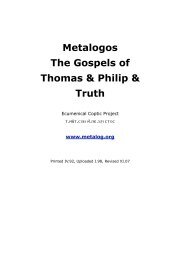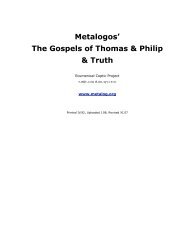Andrew Louth - Syriac Christian Church
Andrew Louth - Syriac Christian Church
Andrew Louth - Syriac Christian Church
You also want an ePaper? Increase the reach of your titles
YUMPU automatically turns print PDFs into web optimized ePapers that Google loves.
INTRODUCTION 49<br />
words ‘person’ (=prosôpon, in Greek) and ‘subsistent being’ (=<br />
hypostasis), used in the Definition to express the unity of Christ, had<br />
already been used in a Trinitarian context to express the distinctness<br />
of the three members of the Trinity, especially by the Cappadocian<br />
Fathers. The words used in Trinitarian theology to express the unity<br />
of the Godhead—being (=ousia) and nature (=physis)—can also be<br />
employed to express what it is that is dual in Christ: in the<br />
Chalcedonian Definition, physis is thus used and ousia occurs as the<br />
root of the term ‘consubstantial’ (=homoousios). This tendency to<br />
interpret Christological terminology in terms of Trinitarian<br />
terminology, and vice versa, was by no means well-established, or even<br />
commonplace, in the century before Chalcedon, nor can it be claimed<br />
that it is at all likely that the Fathers of Chalcedon clearly intended<br />
any such idea: the events in the wake of Chalcedon suggest rather that<br />
there was a good deal of confusion as to what the decisions of that<br />
council really entailed. But, with hindsight, Chalcedon may be<br />
regarded as at least lending encouragement to the use of a consistent<br />
terminology to be applied in both Christological and Trinitarian<br />
contexts.<br />
Maximus takes this further and seeks to work out a thoroughly<br />
consistent ‘Chalcedonian logic’. He is fond of the four ‘Chalcedonian’<br />
adverbs—asynchytôs, atreptôs, adiairetôs, achôristôs (in the quotation<br />
from the Definition above translated as ‘which undergo no confusion,<br />
no change, no division, no separation’)—as key terms in safeguarding<br />
the integrity of the natural. Confusion, change, division and<br />
separation almost invariably carry a negative connotation with<br />
Maximus: it is in these terms that Maximus describes the effects of<br />
the Fall on human beings and the cosmos, effects that do not alter the<br />
fundamental meaning (logos) of natures, but are to be found in the<br />
way fallen natures act and interact, so that confusion, division and<br />
fragmentation obscure the fundamental reality, disclosed by the logos<br />
of each nature, of what God has created. In his early second letter<br />
(translated below), this tendency is already well-developed. But, more<br />
significantly, he takes over from the Cappadocian Fathers one of their<br />
ways of explaining the difference between subsistent being<br />
(hypostasis) and nature in a Trinitarian context, and uses it much<br />
more widely: in fact, it becomes for him a fundamental metaphysical<br />
distinction. To express what it is that is distinctive about the<br />
subsistent beings of the Godhead the Cappadocians had used the term<br />
‘mode of existence’ (=tropos tês hyparxeôs). This leads Maximus to<br />
suggest that at the level of being, we find natures defined by their<br />
principles, meanings or definitions (all of which can be represented in<br />
Greek by the term logos)—ousia, physis, and logos belong together;<br />
whereas at the level of person we find ‘modes of existence’—hyparxis,




